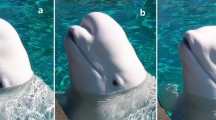Abstract
This study was designed to more clearly define thetreatment of early social isolation. Four newborn infant rhesus monkeys, (Macaca mulatta) were raised in social isolation and their behavioral developmentduring their sojourn in isolation was compared to the behavioral development of four controls which were reared by mothers. The controls were matched with the isolates for age and sex and both groups were studied for 30 weeks. The following conclusions resulted from this study:
-
1.
Infant rhesus monkeys raised in laboratory cages do not display facial expressions very frequently, whether they are isolate-reared or alone with a mother. A search of the literature indicated that facial expressions do not occur frequently early in life even when peers are provided.
-
2.
Isolates spent more time looking at human observers, at the nonsocial environment, and at themselves than did controls while controls looked a their mothers or slept.
-
3.
Isolates showed more walking and more manual exploration of the cage and of themselves than did controls but controls did more cage climbing and jumping, and the latter was often oriented toward the mother. The isolates moved more slowly and awkwardly than did the controls.
-
4.
Isolates did not make as extensive use of towels in their cages as we had expected. Controls were in contact with their mothers much more frequently than isolates were in contact with their towels.
-
5.
Abnormal movements such as rocking, self-grasping, and autoeroticism, appeared in the isolates before the end of thefirst month. Thus, the first month of life is evidently extremely crucial for the development of abnormal behavior. Though many abnormal movements first appear during the first month, each individual isolate apparently does not settle down to his own favorite type of weirdness until well after seven months of age.
Similar content being viewed by others
References
Blomquist, A. J. &H. F. Harlow, 1951. The rhesus monkey program at the University of Wisconsin Primate Laboratory.Proceedings of Animal Care Panel, 11: 57–64.
Boelkins, R. C., 1963. The development of social behavior in the infant rhesus monkey following a period of social isolation. Unpublished master's thesis, Univ. of Wisconson.
Clark, D. L., 1968. Immediate and delayed effects of early, intermediate, and late social isolation in the rhesus monkey. Unpublished doctoral dissertation, Univ. of Wisconsin.
Cross, H. A. &H. F. Harlow, 1965. Prolonged and progressive effects of partial isolation on the behavior of macaque monkeys.J. exp. Med. Res. Personal., 1: 39–49.
Griffin, G. A. &H. F. Harlow, 1966. Effects of three months of total social deprivation on social adjustment and learning in the rhesus monkey.Child Develop., 37: 533–547.
Hinde, R. A. &Y. Spencer-Boothe, 1967. The behavior of socially living rhesus monkeys in their first two and half years.Anim. Beh. 15: 169–196.
Mason, W. A., 1960. The effects of social restriction on the behavior of rhesus monkeys: I. Free social behavior.J. comp. Physiol. Psychol., 53: 582–589.
——, 1963. Behavior of rhesus monkeys raised in isolation.J. psychiat. Res. 1: 299–306.
Mitchell, G., 1970. Abnormal behavior in primates. In:Primate Behavior: Developments in Field and Laboratory Research, Vol. 1, Academic Press, New York, pp. 195–249.
——, 1968. Primiparous and multiparous monkey mothers in a mildly stressful social situation: First three months.Develop. Psychobiol. 1: 280–286.
Odom, B., G. Mitchell, &D. Lindburg, 1970. A device to record primate social behavior.Primates 11: 93–96.
Rowland, G. L., 1964. The effects of total social isolation upon learning and social behavior in rhesus monkeys. Unpublished doctoral dissertation, Univ. of Wisconsin.
Sackett, G. P., 1966. Monkeys reared in isolation with pictures as visual input: Evidence for an innate releasing mechanism.Science 154: 1468–1472.
Author information
Authors and Affiliations
Additional information
Supported by National Institute of Health Grant numbers RR00169, HD04335, MH17425, and MH19760.
About this article
Cite this article
Baysinger, C.M., Brandt, E.M. & Mitchell, G. Development of infant social isolate monkeys (Macaca mulatta) in their isolation environments. Primates 13, 257–270 (1972). https://doi.org/10.1007/BF01730572
Accepted:
Issue Date:
DOI: https://doi.org/10.1007/BF01730572




